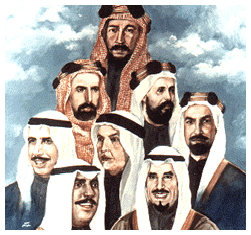KUWAIT

BRIEF HISTORY
A severe famine compelled the Sabah and Khalifa, to leave their traditional homeland of Hadar, in the Aflaj region of central Arabia, during the middle of the seventeenth century. Together with other central Arabian tribes, they formed the Uthbi (wanderers), who settled at Qatar and engaged in the pearl fisheries. They were driven out by the Governor of Bahrain in 1701, then tried to settle at Basra, engaged in piracy for a brief period and eventually settled at Grane, in present day Kuwait.
The family was led by Sabah bin Jabir, from whom the dynasty takes its name, and who arrived at Grane ca. 1746. Until the 1760’s they were one of three leading Uthbi families, each responsible for different aareas of government. The Al-Sabah controlled local administrative matters, the courts and foreign affairs; the Al-Khalifa (see Bahrain) controlled the pearl fishery and commerce; the Al-Jalahima controlled maritime affairs. Only after the departure of the last two families, during the 1760’s, did the Al-Sabah gain undisputed rule over Kuwait.
For half a century the Al-Sabah ruled their little principality unmolested by the outside world. However, the Egyptian expedition against the Wahabi movement in Arabia resulted in heavy-handed attempts by the former to gain control in the gulf, during the early nineteenth century. This sparked mild interest from the Ottoman Governor at Baghdad to do the same. By the 1820s the British were increasing their attempts at subduing piracy and suppressing the slave trade in the gulf. It took some astute diplomacy on the part of Shaikh Jabir I to avoid any entanglements with these foreign powers.
There were further attempts by the Turks during the 1870s and 1890s, in which they attempted to incorporate Kuwait more formally within the Ottoman Empire. The Shaikh was granted the title of Pasha and recognised as a Qaimmakam or Deputy Governor, under the Governor of Iraq. This prompted Shaikh Mubarak I, who came to power in a violet coup d’etat against his brothers, to seek a closer alliance with the British, the leading power in the region. After three requests for a protectorate, the British finally agreed to one in 1899.

An elected Legislative Assembly was conceded in 1938, it achieved several important reforms, but it was closed by the ruler within six months. 1938 proved a momentous year, oil was struck for the first time. By 1959 the trickle of income from oil had risen to an estimated £150 million p.a., providing an income beyond the wildest dreams of any Kuwaiti. The government and administration called for reform and transformation. Ministries and departments of state were established in all areas, education rapidly expanded, and development accelerated.
By mutual consent both Britain and Kuwait agreed to terminate the protectorate in the Treaty of Independence of 1961. Before the ink was dry, the Iraqi dictator Qasim made a bid to incorporate Kuwait into Iraq. Only the timely arrival of British troops, and condemnation by the international community, averted an invasion.
Soon after independence further reforms resulted in the opening of an elected parliament in 1963. Ever increasing oil income prompted enormous development and social improvement. However, external pressures began to press upon Kuwait, particularly after the fall of the Shah of Iran in 1979. Saddam Hussain of Iraq began to flex his muscles I the region, forcing Kuwait to abandon its non-aligned policy. Repeated claims to Kuwait, nascent since the days of King Ghazi, now became more voiciferous and beligerent. He invaded in 1990, expecting world opinion to ignore his aggression. The Iraqi invaders were repulsed by a coalition of countries led by the US and Saudi Arabia in 1991.
STYLES & TITLES:
The Sovereign: Shaikh (personal name) bin (father’s name) Al-Sabah, Amir of the State of Kuwait, with the style of His Highness.
The Heir Apparent: Shaikh (personal name) bin (father’s name) Al-Sabah, Crown Prince of the State of Kuwait, with the style of His Highness.
Other male descendants of rulers, in the male line: Shaikh (personal name) bin (father’s name) Al-Sabah.
Other female descendants of rulers, in the male line: Shaikha (personal name) bint (father’s name) Al-Sabah.
Note: some members of the ruling family also use the name of their grandfather or progenitor of their particular bracnch of the family as a distinguishing name, e.g. Shaikh Ahmad bin Muhammd al-Fulan Al-Sabah.
RULES OF SUCCESSION:
Hereditary Amirate, the succession to which is limited to the descendants of Mubarak Al-Sabah. The Heir Apparent must be designated by the reigning Amir within one year, at the latest, from the date of his accession. The nomination must be approved by a majority of members of the National Assembly, sitting in special session. Nomination as Heir Apparent is limited to persons who are thirty years of age on the date of his proclamation (AD), of sound mind, and the legitimate son of Muslim parents.
ORDERS & DECORATIONS:
See separate page - link below.
SOURCES:
Burke’s Royal Families of the World. Volume II: Africa & The Middle East. Burke’s Publications Ltd., London, 1980.
Who’s Who in the Arab World, Publitec Publications, London, 1967-1999.
SPECIAL ACKNOWLEDGEMENT:
Dr. Morris L. Bierbrier, FSA.
Dr. Khaled Al-Fadhel.
Copyright©Christopher Buyers, September 2001 - June 2024